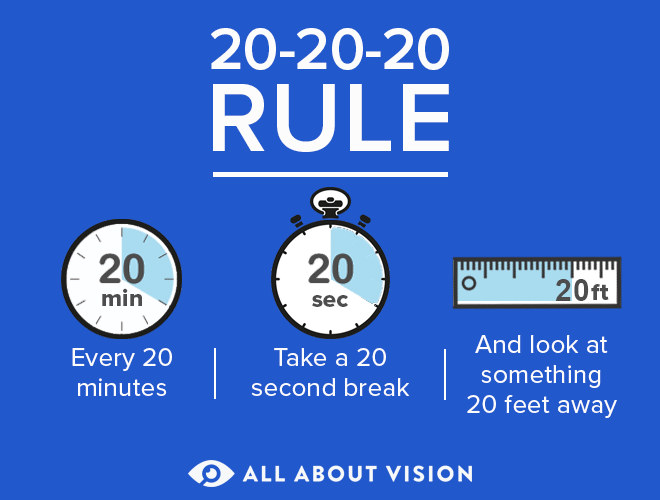Simple ways to reduce computer eye strain

Between scrolling through your social media feed (thanks for reading!), bingeing a Netflix series about wild cats and courageously battling through a Fortnite marathon, your eyes are focusing on digital devices for long periods of time. This can take a toll on your eyes, and the easiest way to find relief from digital eye strain is to reduce your screen time.
What is digital eye strain?
Digital eye strain can result from focusing up close on a screen for extended periods. Some symptoms that can be caused by all that time staring at screens are headaches, blurred vision, poor sleep and watery, tired or dry eyes. While the symptoms of digital eye strain are often temporary, too much screen time also has been shown to intensify and accelerate preexisting eye conditions.
5 tips to reduce your digital eye strain
1. Give your screen and your eyes a break

It can feel unnecessary to take breaks from that new docu-series you’re hooked on, especially when there isn’t much else to do at home. However, applying the “20-20-20” rule to your streaming regimen can keep symptoms of digital eye strain at bay.
For every 20 minutes of screen exposure, pause and stare at an object 20 feet away for 20 seconds.
On top of these little pauses, take longer breaks from your screen. Every hour or so, get up and stretch your legs.
If you really want to treat yourself, go outside. Do some work in your yard or take your pets for a walk — get some fresh air in your lungs and remind yourself that planet Earth is still intact. Your laptop, smartphone and TV will still be there when you return.
SEE RELATED: How to take care of your eyes while stuck at home
2. Blink more often
When cooped up at home, it’s tempting to become a “screen zombie.” How to slay this zombie? Blink!
According to researchers, you typically blink 15-20 times per minute. While you’re staring at the little glowing rectangle in your hand, you’re only blinking 5-7 times per minute. Of course your eyes are dry!
Blinking is how your eyes stay moist and wash out irritating debris, so whenever you’re playing a video game or watching TV, remember to blink. Your eyes will only be closed for a tenth of a second, so we promise you won’t miss anything!
3. Adjust your screen display settings
Many smartphones, tablets and computers allow you to adjust the display settings to make screen viewing easier on your eyes.
A good rule of thumb: Keep your screen at the same brightness as your work environment. Displays that are too dark or too bright can create a glare on your screen that may strain your eyes.
Some smartphones allow users to put their display on “dark mode,” which shows white letters on a dark background. The setting is said to be easier on eyes than the stark white background that phones typically have.
Another way to reduce digital eye strain is to increase the type size on your screen. Making the print larger can make the text is easier to read. No more squinting and straining to read!
Reading glasses made for computers are another great option to magnify small, hard-to-read text on your phone or computer screen.
4. Wear computer glasses
Computer glasses are customized to help your eyes feel more comfortable working on digital devices. They often have a prescription that helps you focus at an intermediate computer distance. In addition, these glasses often feature an anti-reflective coating and blue-light filtering lenses to help decrease glare.
You can buy blue light lenses with any prescription strength — or you can buy blue light glasses without a prescription. Once you have them, you can test how well your blue light glasses work.
5. Get a comprehensive eye exam
Regular eye exams are a good way to relief from digital eye strain symptoms and to check the overall health of your eyes. Screen time might not be the reason for your headaches or blurry vision. You may just need a new prescription for glasses or contacts.
Most eye doctors currently aren't offering routine eye exams leading to an eye exam, following the recommendation of the Centers for Disease Control and Prevention, but many offices are offering virtual visits.
RELATED READING: What is asthenopia?
Page published on Wednesday, May 6, 2020






